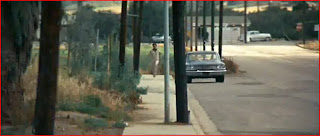V. Film Language and Representation
In the last five minutes of The Graduate, we are already knowing of what the conflict is. We see how the notification of Elain's location fuels Benjamin to rush to the wedding chapel and stop the wedding. We see Benjamin as this desperate person who must now reach his destination in time or else. We see these long takes of shots to portray the realism of the situation, which allows the actor to portray his natural feelings with no breaks in continuity.
The use of this shot was to explain the need for Benjamin to get his destination. This shot makes the situation seem like its being dragged on and that Benjamin is not going to make it in time. This shot also portray realism as the objects around Benjamin are in its natural setting and there is no alteration to the shot or the setting. We also see how shots like this one allow the audience to feel a bit disgruntled as they want Benjamin to reach his destination in time rather than not make it.
The lighting in this shots allows the visual of Benjamin's emotions. The fill light was used to soften up the shadows caused by the key light on Benjamin's face, allowing his left side to be somewhat illuminated while the other is a bit darker. This use of lighting allows us to see what is being portrayed by Benjamin and what we are to expect. The use of bland colors gives the situation this gloomy mood, as it relates to the dissatisfaction and sadness that Benjamin is feeling.
In this shot, the use of music gives away this sense of success. As both Benjamin and Elaine smile at each other and look away, the music fades in that matches what they are feeling. The music is somewhat slow and soothing, which also matches what is happening in the shot. The absence of dialogue is appropriate as the audience already knows what is happening in the shot simple by what both the characters are just doing.
In many of these shots, the audience's attention is first directed to Benjamin, as he is the main object in motion in these shots. Many of the shots used are loose, as we see the whole scenery around Benjamin as he is running to the chapel. Many of the shots are naturally lit, allowing the sequence to give it a sense of realism. There isn't much "eye catchers" throughout the extract, as mostly everything in the shots are darkish colors, expect the times where we see the red car or the yellow bus. Throughout this extract, there are very powerful emotions of love and commitment. Benjamin is fully committed to reaching Elaine and saving her for himself. The re-occurring theme of love allows the audience to feel what Benjamin feels for Elaine and how he'll do anything just for her.




